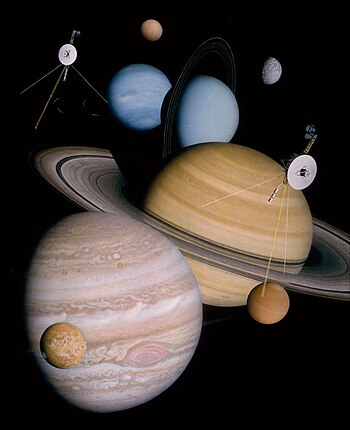
Back Voyager-program Afrikaans برنامج فوياجر Arabic Voyager AST Voyacer proqramı Azerbaijani وویجر برنامهسی AZB Касмічная праграма «Вояджэр» Byelorussian Вояджэр (касьмічная праграма) BE-X-OLD Вояджър (програма) Bulgarian ভয়েজার কর্মসূচি Bengali/Bangla Program "Voyager" BS

The Voyager program is an American scientific program that employs two interstellar probes, Voyager 1 and Voyager 2. They were launched in 1977 to take advantage of a favorable alignment of the two gas giants Jupiter and Saturn and the ice giants, Uranus and Neptune, to fly near them while collecting data for transmission back to Earth. After launch, the decision was made to send Voyager 2 near Uranus and Neptune to collect data for transmission back to Earth.[1]
As of 2024,[update] the Voyagers are still in operation beyond the outer boundary of the heliosphere in interstellar space. They collect and transmit useful data to Earth.
Voyager did things no one predicted, found scenes no one expected, and promises to outlive its inventors. Like a great painting or an abiding institution, it has acquired an existence of its own, a destiny beyond the grasp of its handlers.
As of 2023[update], Voyager 1 is moving with a velocity of 61,198 kilometers per hour (38,027 mph), or 17 km/s, relative to the Sun, and is 24,211,500,000 kilometers (1.50443×1010 mi) from the Sun[2] reaching a distance of 161.844 AU (24.2 billion km; 15.0 billion mi) from Earth as of November 25, 2023.[3] On 25 August 2012, data from Voyager 1 indicated that it had entered interstellar space.[4]
As of 2023[update], Voyager 2 is moving with a velocity of 55,347 kilometers per hour (34,391 mph), or 15 km/s, relative to the Sun, and is 20,203,800,000 kilometers (1.25541×1010 mi) from the Sun[5] reaching a distance of 135.054 AU (20.2 billion km; 12.6 billion mi) from Earth as of November 25, 2023.[3] On 5 November 2019, data from Voyager 2 indicated that it also had entered interstellar space.[6] On 4 November 2019, scientists reported that, on 5 November 2018, the Voyager 2 probe had officially reached the interstellar medium (ISM), a region of outer space beyond the influence of the solar wind, as did Voyager 1 in 2012.[7][8]
Although the Voyagers have moved beyond the influence of the solar wind, they still have a long way to go before exiting the Solar System. NASA indicates "[I]f we define our solar system as the Sun and everything that primarily orbits the Sun, Voyager 1 will remain within the confines of the solar system until it emerges from the Oort cloud in another 14,000 to 28,000 years."[9]
Data and photographs collected by the Voyagers' cameras, magnetometers and other instruments revealed unknown details about each of the four giant planets and their moons. Close-up images from the spacecraft charted Jupiter's complex cloud forms, winds and storm systems and discovered volcanic activity on its moon Io. Saturn's rings were found to have enigmatic braids, kinks and spokes and to be accompanied by myriad "ringlets".
At Uranus, Voyager 2 discovered a substantial magnetic field around the planet and ten more moons. Its flyby of Neptune uncovered three rings and six hitherto unknown moons, a planetary magnetic field and complex, widely distributed auroras. As of 2023, Voyager 2 remains the only spacecraft to have ever visited the ice giants Uranus and Neptune.
In August 2018, NASA confirmed, based on results by the New Horizons spacecraft, the existence of a "hydrogen wall" at the outer edges of the Solar System that was first detected in 1992 by the two Voyager spacecraft.[10][11]
The Voyager spacecraft were built at the Jet Propulsion Laboratory in Southern California and funded by the National Aeronautics and Space Administration (NASA), which also financed their launches from Cape Canaveral, Florida, their tracking and everything else concerning the probes.
The cost of the original program was $865 million, with the later-added Voyager Interstellar Mission costing an extra $30 million.[12]
- ^ a b "The Fantastic Voyage of Voyager". The Attic. 9 January 2020. Retrieved 3 March 2020.
- ^ "Voyager Mission Status". JPL. Retrieved 10 February 2022.
- ^ a b "Voyager - Mission Status". Jet Propulsion Laboratory. National Aeronautics and Space Administration. Retrieved 24 April 2021.
- ^ Cite error: The named reference
JPL.NASAwas invoked but never defined (see the help page). - ^ "In Depth - Voyager 2". JPL. Retrieved 10 February 2022.
- ^ Cite error: The named reference
NASA-20181210was invoked but never defined (see the help page). - ^ University of Iowa (4 November 2019). "Voyager 2 reaches interstellar space - Iowa-led instrument detects plasma density jump, confirming spacecraft has entered the realm of the stars". EurekAlert!. Retrieved 4 November 2019.
- ^ Chang, Kenneth (4 November 2019). "Voyager 2's Discoveries From Interstellar Space - In its journey beyond the boundary of the solar wind's bubble, the probe observed some notable differences from its twin, Voyager 1". The New York Times. Retrieved 5 November 2019.
- ^ "Solar System Exploration". JPL-NASA. Retrieved 19 February 2021.
- ^ Gladstone, G. Randall; et al. (7 August 2018). "The Lyman-α Sky Background as Observed by New Horizons". Geophysical Research Letters. 45 (16): 8022–8028. arXiv:1808.00400. Bibcode:2018GeoRL..45.8022G. doi:10.1029/2018GL078808. S2CID 119395450.
- ^ Letzter, Rafi (9 August 2018). "NASA Spotted a Vast, Glowing 'Hydrogen Wall' at the Edge of Our Solar System". Live Science. Retrieved 10 August 2018.
- ^ "Voyager - Fact Sheet". voyager.jpl.nasa.gov.
© MMXXIII Rich X Search. We shall prevail. All rights reserved. Rich X Search